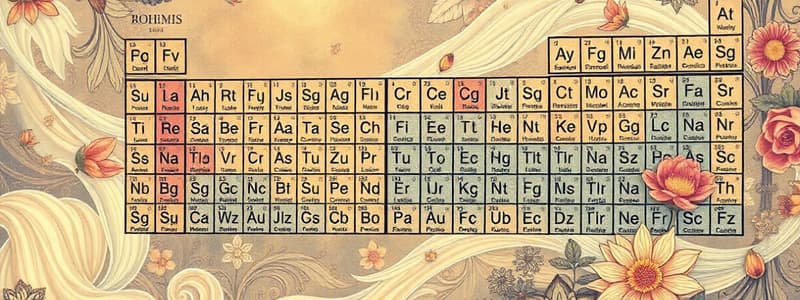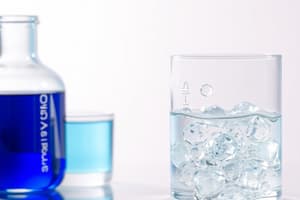Podcast
Questions and Answers
What is one recommended activity for students to enhance their understanding of aqueous solutions?
What is one recommended activity for students to enhance their understanding of aqueous solutions?
- Attend the sessions regularly (correct)
- Skip assignments to focus on handouts
- Only print handouts for reference
- Study only before tests
Which of the following is not a suggested method for effective study habits mentioned?
Which of the following is not a suggested method for effective study habits mentioned?
- Completing assignments thoroughly
- Avoiding group study sessions (correct)
- Adding notes to study materials
- Highlighting important sections in handouts
Which action should be prioritized according to effective learning strategies?
Which action should be prioritized according to effective learning strategies?
- Solving test banks (correct)
- Relying solely on textbooks for information
- Ignoring class attendance
- Watching videos on chemistry concepts exclusively
What is a vital component of preparing for exams in the context of aqueous solutions?
What is a vital component of preparing for exams in the context of aqueous solutions?
Which of the following strategies is least effective for mastering aqueous solutions?
Which of the following strategies is least effective for mastering aqueous solutions?
Flashcards
Aqueous Solution
Aqueous Solution
A type of chemical solution where the solvent is water.
Test Banks
Test Banks
A collection of problems designed to test understanding of a subject, often with sample answers provided.
Assignment
Assignment
A set of exercises, problems, or activities assigned to a student for completion outside of class.
Study
Study
Signup and view all the flashcards
Handout
Handout
Signup and view all the flashcards
Study Notes
Royal Society of Chemistry Study Notes
- Course: Seniors 26, Grade 11
- Learning Objective (LO.1): Aqueous Solutions
- Session: 1
- Preparation: Solve test banks, complete assignments, study diligently, print and highlight handouts, add notes, and attend sessions.
Periodic Table of the Elements
- Data: The table organizes elements based on atomic number, electron configuration, and properties.
- Data: Standard atomic weight (or most stable mass number) noted for each element.
- Data: First ionization energy in kJ/mol.
- Data: Oxidation states (most common highlighted).
- Information: Radioactive elements have masses in parentheses.
- Classification: Alkali metals, alkaline earth metals, transition metals, lanthanides, actinides, nonmetals, reactive nonmetals, noble gases, metalloids, unknown properties, and post-transition metals.
Cover Note/Essential Questions and Concepts - Session 1
- Topic: Purification of Water Supply
- Topic: Processes for converting seawater to potable water
- Essential Question: How can pure, drinkable water be obtained?
- Concepts:
- Solutions and aqueous solutions
- Solubilities of salts (temperature impact)
- Solubility curves
- ppm
- Molarity
- Molality
- Normality
- Mole fraction
- Mass percentage
- TDS
- Strength
- Titers
- DO
- Percentage of ions needed by the human body daily
- Methods of Purification:
- Resins (including ion exchange)
- EDTA
- Electrodialysis
- Simple distillation
- Filtration
- Adsorption
- Sedimentation/alum
- Biological treatment
- Oxygenation
- Osmosis and reverse osmosis
- Dissolved oxygen
- Quantitative analysis
- Qualitative analysis
Additional Conceptual Questions
- Q1: If a 1 M solution is reduced to half its volume, the concentration doubles.
- Q2: Heating a 1 M solution (without evaporation) does not change the concentration.
- Q3: Heating a 1 M solution until 2/3 evaporates increases the concentration to 3/2 M.
- Q4: Cooling a 1 M solution until 1/3 freezes increases the concentration to 3/2 M.
- Q5: Doubling the volume of a 1 M solution halves the concentration.
- Concentration Factors Affected by Temperature: Molarity
- Solution of 0.5 Moles of NaCl in 1 Liter: Semimolar solution
- To Half the Molarity of a Solution: Double the volume of the solution.
- Molarity of 600 g H2O: 55.5 M
Concentration of a Solution using (M1V1=M2V2)
- Problem 1: Calculation of amount concentration of sulfuric acid (H2SO4)
- Problem 2: Calculating volume of sodium hypochlorite (NaClO)
- Note: Use appropriate units (e.g., mL or L) and molar masses (Mm).
Additional Calculations/Practice Problems
- Different methods to express concentration: Molarity, Molality, Mass%, Volume %, Strength, Titre, Normality, Mole fraction, ppm.
- Problem 1 (Practice): Final concentration after dilution of car battery acid.
- Problem 2 (Practice): Volume of sodium hydroxide solution required.
- Problem 3 (Practice): Amount concentration of ethanoic acid (acetic acid).
- Problem 4 (Practice): Amount concentration of iron(III) nitrate stock solution.
- Problem 5 (Dilution): Procedure for preparing a 0.4 M solution from 1 M CuSO4, with calculation of water that needed to be added.
- Problem 6 (Dilution): Final concentration of nitric acid solution after dilution.
- Practice 2 (Preparation of Solution): Procedures for preparing 1M Sodium hydroxide and 0.1M KMnO4
- Conceptual Problems (Q1-Q5): Understanding how solution volume affect concentration, effect of temperature. Molarity calculation from volumes and moles.
- Solutions With Same Molarity: Calculating mass required for different solutions to have the same colligative molarity.
Additional Notes
- Total Ion Concentration: Arranging solutions in order of increasing total ion concentration.
- Electrolytes : Classify and calculate concentration when adding electrolytes that produce same different ions
- Different Solutes Added and Volumes: Calculating moles of solid CaCl2 needed to adjust concentration in a solution.
Studying That Suits You
Use AI to generate personalized quizzes and flashcards to suit your learning preferences.
Related Documents
Description
This quiz covers essential concepts from the Royal Society of Chemistry study notes for Grade 11 students. Topics include aqueous solutions, the periodic table of elements, and key properties such as ionization energy and oxidation states. Prepare effectively with this targeted quiz.




